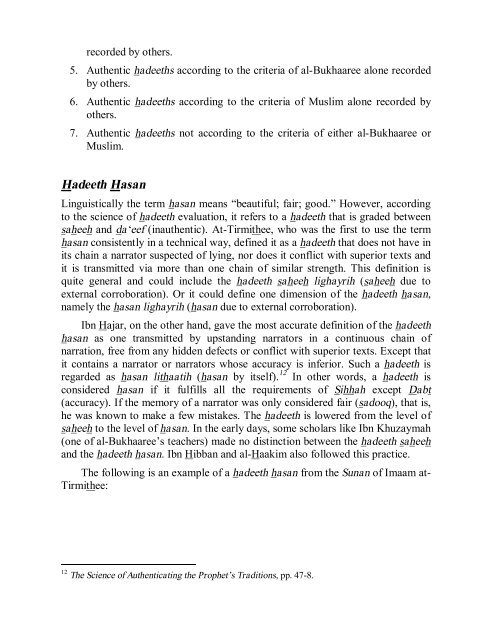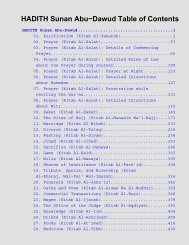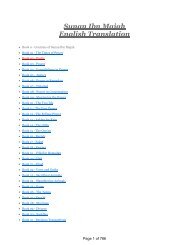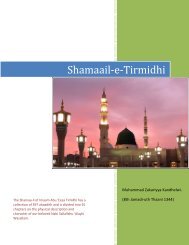Create successful ePaper yourself
Turn your PDF publications into a flip-book with our unique Google optimized e-Paper software.
ecorded by others.5. Authentic hadeeths according to the criteria of <strong>al</strong>-Bukhaaree <strong>al</strong>one recordedby others.6. Authentic hadeeths according to the criteria of Muslim <strong>al</strong>one recorded byothers.7. Authentic hadeeths not according to the criteria of either <strong>al</strong>-Bukhaaree orMuslim.Hadeeth HasanLinguistic<strong>al</strong>ly the term hasan means “beautiful; fair; good.” However, accordingto the science of hadeeth ev<strong>al</strong>uation, it refers to a hadeeth that is graded betweensaheeh and da‘eef (inauthentic). At-Tirmithee, who was the first to use the termhasan consistently in a technic<strong>al</strong> way, defined it as a hadeeth that does not have inits chain a narrator suspected of lying, nor does it conflict with superior texts andit is transmitted via more than one chain of similar strength. This definition isquite gener<strong>al</strong> and could include the hadeeth saheeh lighayrih (saheeh due toextern<strong>al</strong> corroboration). Or it could define one dimension of the hadeeth hasan,namely the hasan lighayrih (hasan due to extern<strong>al</strong> corroboration).Ibn Hajar, on the other hand, gave the most accurate definition of the hadeethhasan as one transmitted by upstanding narrators in a continuous chain ofnarration, free from any hidden defects or conflict with superior texts. Except thatit contains a narrator or narrators whose accuracy is inferior. Such a hadeeth isregarded as hasan lithaatih (hasan by itself). 12 In other words, a hadeeth isconsidered hasan if it fulfills <strong>al</strong>l the requirements of Sihhah except Dabt(accuracy). If the memory of a narrator was only considered fair (sadooq), that is,he was known to make a few mistakes. The hadeeth is lowered from the level ofsaheeh to the level of hasan. In the early days, some scholars like Ibn Khuzaymah(one of <strong>al</strong>-Bukhaaree’s teachers) made no distinction between the hadeeth saheehand the hadeeth hasan. Ibn Hibban and <strong>al</strong>-Haakim <strong>al</strong>so followed this practice.The following is an example of a hadeeth hasan from the Sunan of Imaam at-Tirmithee:12 The Science of Authenticating the Prophet’s Traditions, pp. 47-8.





